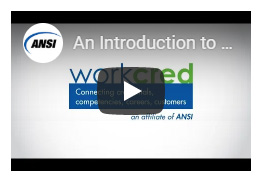Creating a More Integrated and Effective Credentialing System
True or False: The U.S. credentialing system is confusing and impossible to navigate.
The answer is perhaps less straightforward than you might think.
Let’s face it: The U.S. credentialing system is confusing. From certifications, licenses, and numerous different types of certificates to MicroMasters, badges, and superbadges,
the number and variety of credentials is growing. This leads to a great deal of head scratching, as job seekers and employers become even more confused about how one credential differs from another,
which lead to skill attainment and opportunity, and most importantly – how to tell a quality credential from one that is simply a ticket to nowhere.

In our new video, Workcred illustrates some of the confusion that employers, credentialing organizations, and education and training providers are facing as new types of credentials enter the market,
and how Workcred is focused on connecting and educating stakeholders to create a more integrated and effective credentialing system.
At Workcred, we believe the more we can bring different stakeholders together to create joint solutions to shared problems, the better the outcomes will be for students, the workforce, and the strength of the economy.
In one major initiative, Workcred has joined forces with the Association of Public and Land-grant Universities (APLU) and the University Professional and Continuing Education Association (UPCEA) to explore how students can earn both degrees
and certifications as part of their four-year degree program. Thanks to a Lumina Foundation grant, we are hosting a series of national convenings, bringing certification bodies and universities together to identify opportunities to give
academic credit for earning a certificate, embed certifications within four-year degree programs, and align curriculum with the competencies in the certification exam content. Our upcoming meeting in July will focus on opportunities related
to cybersecurity and will build upon the outcomes of our first convening on health care. Over the coming months, we will also seek to uncover opportunities in the liberal arts, manufacturing, and retail/hospitality, as well as opportunities
to embed certifications for cross-cutting skills, such as project management and human resources, within degrees related to each sector. The ultimate output from these discussions will be a framework for pilot programs to test different
strategies and practices to better align certifications and degrees.
We are thrilled to see, even in the early days of the initiative, immense enthusiasm on the part of both certification bodies and universities to create partnerships that will benefit students. It really is proof of the power of partnerships.
So, returning to my initial question – the U.S. credentialing system is confusing and impossible to navigate – true or false? The correct response is true if one isn't educated on the various credentialing, education, and workforce
communities and how they need to work together.
The U.S. credentialing system is confusing for many, and can be a bit of a bumpy road. But it is by no means impossible to navigate. Together, through partnerships and facilitation, we are creating new avenues of communication and
pathways to build solutions and a shared path forward.
I look forward to sharing more insights and outcomes from the convenings in the near future, and to sharing details of the new partnerships and initiatives we are forging to better integrate the credentialing community
into the broader education and workforce world. In the meantime, you can reach out to me at [email protected] or catch the latest at www.workcred.org.
Best regards,

Roy A. Swift